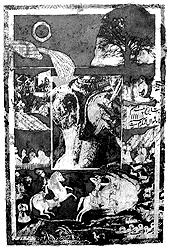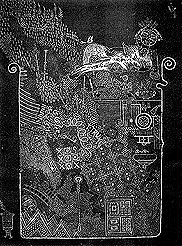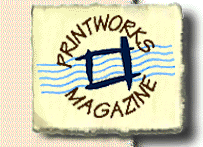For the printmaker the range of possible materials, the
surface of contact between the artist and his environment are immense. Thus the techniques of thought and method of access to the im-agination1 are vital
and abundant. But it is only through need to express new forms that we explore the means
to convey them.
Printmaking in Pakistan is struggling to establish itself
as a legitimate means of expression. I respond to this from the position of a young
printmaker who has recently come to Karachi. I propose to give a brief summary of the
development of the medium in Pakistan, of the conditions for printmakers in terms of
access to materials, and of the general public's response to printmaking.
Lahore, the traditional cultural capital of
Pakistan, has two of the largest art establishments2 in the country and, hence, a greater support network for art activity. The
printmaking department of Punjab University was founded in 1940 by Ana Molka Ahmed, of
Russian and Polish descent (1917-1994). She received her artistic training at St Martin's
and then at the Royal College of Art, both in London, where she met and married Sheikh
Ahmed. Lithography and relief printing were practised until 1964, when an intaglio press
was introduced. Lithography stones had been acquired from the Bible Society during the
late thirties and script is still visible on some of these stones, which have not been
ground and printed for over six decades. The print studio is now run by Chazanfar Ali (b.
1941), an accomplished and committed printmaker.
 |
History was a Court Dancer
by Anwar Saeed
Photoetching |
The National College of Art, also in Lahore, established a
printmaking department in the fifties. With growing demands by students, the facilities of
lithography, photo etching, scre-enprinting and relief printing have expanded, with a
Brand press being donated by the America Cultural Centre in 1985. The department was set
up initially by Ustad Lateef Chughtai, but really took off in 1985 with the efforts of
Naazish Ataullah, Mshar Afshar and Anwar Saeed. Sabah Hussain, also based in Lahore, runs
workshops in printmaking and paper making. She studied in Kyoto Japan, for four years,
where she did her Masters and worked in Tomikichiro's atelier.
Karachi has a number of art schools, which are establishing
substantial print departments. Meher Afroze, one of the senior printmakers, also has her
studio in Karachi. The city has about ten intaglio presses, five of which are in private
studios. However, there are no non-commercial lithography or relief presses in use, or
printmaking co-operatives for artists to ex-periment in an atmosphere of collaboration.
Jamal Shah did his Masters in printmaking at the Slade in
London in 1988. He set up the Fine Art department at the University of Balochistan and
went on to establish two new art schools in Islamabad. His prints have vitality and energy
which reflect his interest in sculpture.
Post-partition was a time of great cultural transition; it
was about trying to redefine a new identity for a nation, simultaneously distinguishing
itself from an identifiably Indian culture and striving to be modern. This dilemma
affected writers, philosophers and artists and has yet to be resolved. Traditional
printmaking techniques were successfully explored by Abdur Rehman Chughtai (1899-1975) and
Sadequain (1930- 1987). Although there was a strong Western influence in the form of
cubism and abstract art in painting, there was very little awareness of the Print
Renaissance in the West.
Direct influence from the West came in the form of
sponsored workshops, the first of which was held in 1967 by the American Michael
Ponce-1e-Leon. It created great enthusiasm amongst leading artists such as Bashir Mirza
(b. 1941), Saeed Akhta (b. 1938), Shahid Sajjad (b. 1937) and Ahmed Khan (b. 1939). This
was followed in 1986 by workshops with Bartolomeu dos Santos, from the Slade Print
Department in London and later Peter Daglish RE. In 1992-1993 Walter Crump, from the US,
came on a Fulbright scholarship and taught for a year at the National College of Art.
These workshops played a vital role in extending the
knowledge base to a younger generation of artists and began to establish an integrity and
independence for the original print. They gave an essential two-way link between
printmaking activities abroad and the traditional indigenous importance given to works on
paper.
However, despite isolated periods of activity, the full
poten-tial of this medium has yet to be exploited. There is very little government funding
and much is done through personal initia-tion. One would imagine that prints should be
economically viable, but artists address themselves to an audience with an ambivalent
attitude towards the idea of the editioned print.
One of the main problems is access to equipment and
materials. There is a dearth of quality paper and inks for intaglio printing. Etching
grounds have to be made from the raw materials and acids are not guaranteed to be pure.
Some hand-made paper is bought from India, and Arches and Rives are sold intermittently.
Artists are now making recycled paper that is heavier and more absorbent, but this cannot
fulfil the demand for paper from professional artists. Mohammed Kazim, for example, has
been making paper from sugar cane pulp. This technique is an integral part of his relief
prints.
These problems can, however, be overcome. The real
challenge is to create an awareness of the unique quality of the print, to extend
printmaking to a broader base of artists through group workshops and art schools. Lala
Rukh, based in Lahore, has approached this problem from a different angle. She has set up
photo screenprinting workshops in kaachi aabadis (low in-come areas) to teach women this
technique from a commercial point of view. But would we call this 'Art'? I believe this
would popularise the art form, make it more democratic and accessible, as did the Ukiyoe
prints in Japan or Possada's prints in Mexico in the twenties.
 |
Life Bin
by Afshar Malik
intaglio and relief |
Two artists making significant work are teaching and
working in Lahore. Afshar Malik graduated from the Slade printmaking department in London.
His intricately and densely woven images convey a sense of history and time flowing across
the page; the plates are etched and then printed in relief. Anwar Saeed's photo etchings
juxtapose Arabic text, fragments of min-iatures with parts of ancient Hindu sculptures.
Each disparate element brings with it a history. One gets a strange sense of time, as if
objects used from various periods of existence had been compressed and subjected to the
same time continuum. The work attempts to express a whole civilisation that is part of a
modern identity.
The assumption that artists had to have a recognisable
style prevented the regeneration of their work with vigorous ex-perimentation. With more
cross-fertilisation of ideas and processes, printmaking can offer a direction out of this
crisis. My aspirations for greater activity in this area are immense. The inherent
diversity of this medium is a parallel to the complexity of ideas and forms in an
environment that is constantly chang-ing and developing, where our experience is
constantly shifting.
 The information resource
for printmakers
The information resource
for printmakers  The information resource
for printmakers
The information resource
for printmakers